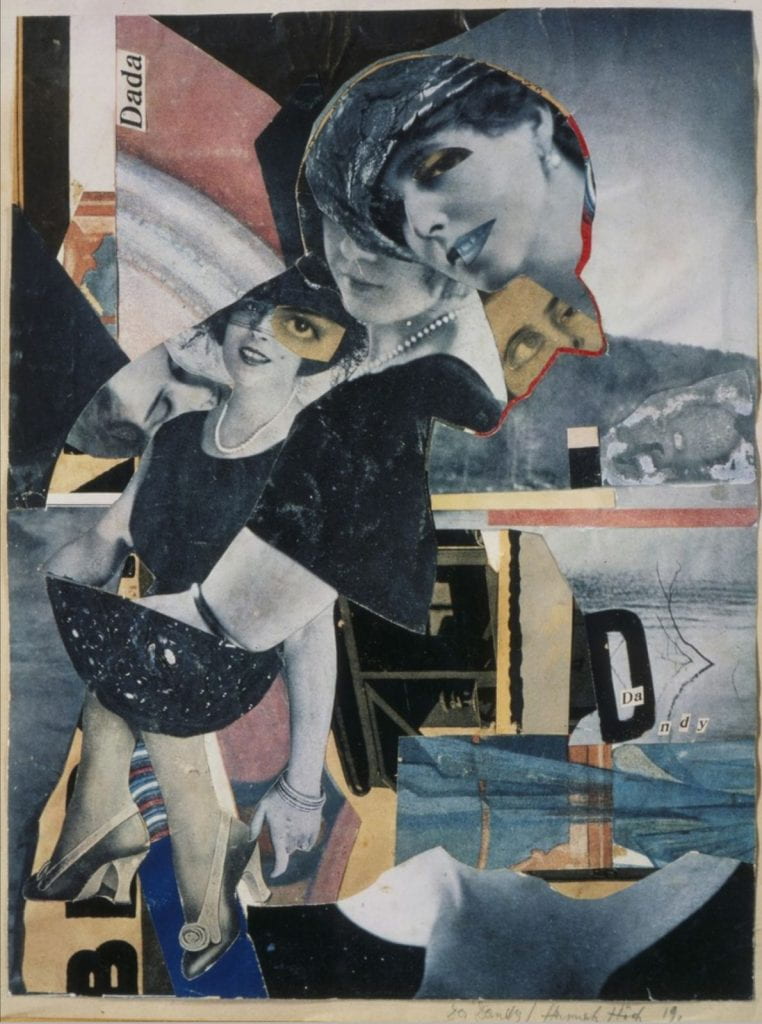Hannah Höch’s Da Dandy
Written by Abigail Smith
Dear D(art)mouth,
Da-Dandy by Hannah Höch is a collage of images of women in dandy-style dress, a flirty, upper-class style of the 1920’s just coming into vogue when Höch created this piece in 1919. In this collage she has compiled essential elements of the style: velvet dresses, luxurious, pearls, and heels. Höch frequently placed women at the forefront of her art. This is a direct criticism of gender relations in Germany at the time. She entered the art scene in Berlin in the height of World War I and at the beginning of the Dada movement which harbored anti-war and anti-establishment sentiments. As the new Weimar government rose, so did Höch’s questions about her place in society. In Berlin, the notion of the New Woman was on the rise. The New Woman was fashionable, on the go, and working, all while sporting a flirty bob. The women of Da-Dandy were far removed from the working class New Woman. The dandy style was for Bourgeois women who were exempt from the struggles of the working class in Germany. Höch’s art often critiqued the Bourgeois woman, something which can be seen in Da-Dandy. A notable feature of the piece is the way the cut out images of the women form the silhouette of a man’s profile, almost as if Höch is saying that the women of the Bourgeois are complicit in misogyny.

Hannah Höch, Da-Dandy, 1919, Photomontage, 30.5 cm x 24 cm, Private collection.
Image via https://towardsdatascience.com
The class struggle women experience has been represented in art many times, although Höch’s raising of this issue is incredibly interesting within the context of her work. After World War I in Germany, the Weimar Republic brought about the promise of a modern age of machinery and government. Women experienced more sexual freedom and culture was booming. Yet the dark side of this period cannot be ignored. Nazi Germany was on the horizon and the sentiments perpetuated in that period were growing from an undercurrent to a tidal wave. The golden glow of liberation was soon to give way to fascism in a violent seizure of the optimism of the Weimar Republic. With Nazi Germany came the Aryan woman, a homemaker and instrument of Nationalism, crushing the optimism of the New Woman style.
Höch’s Da-Dandy represents the musings of a middle-class woman. While fashion and governments may change, to Höch, the upper class often remains untouched. Da-Dandy is a caricature of a moment in fashion, dandy, but in conversation with Höch’s larger body of work, it is yet another symbol of the way upper-class women are exempt from worry about labor, women’s liberation, and political regimes. While fashion seems insignificant, women are constantly pressured to conform to its changing whims. As well, fashion varies incredibly across class divides. In Da-Dandy, Hannah Höch asks her viewer to consider where they stand in society not only in terms of gender but class. Then, in true Dada fashion, Höch turns our understanding of society upside down. This work is a precursor to the questions artists are still asking about the role of art in society. Hannah Höch and the Dada movement began to deconstruct the notions of what art was and how the viewer is meant to interact with it. In Da-Dandy, Höch was able to combine the outlandish nature of the Dada style with her criticisms of Bourgeois society. Hannah Höch is an example of the way art can serve as a supplement to our understanding of reality and is a blueprint for artists being able to politicize the absurd.
Yours,
Abby
Related Articles
“Fae’s Deception” Book Review
Chelsea-Starr reviews Fae’s Deception by M. Lynn and Melissa Craven!
Follow My Lead, a music video
An incredible music video from Stavros!
Scene
scene
when i see the pictures i can still
remember it. light glittering on your legs…

